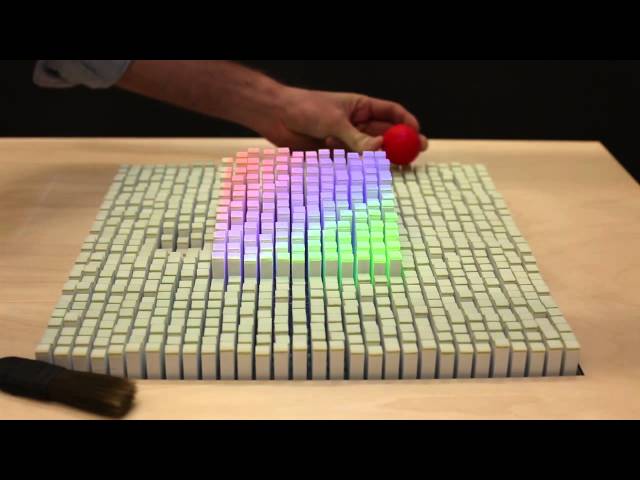Amazing Technology Invented By MIT – Tangible Media
At the MIT Media Lab, the Tangible Media Group believes the future of computing is tactile. Unveiled today, the inFORM is MIT’s new scrying pool for imagining the interfaces of tomorrow. Almost like a table of living clay, the inFORM is a surface that three-dimensionally changes shape, allowing users to not only interact with digital content in meatspace, but even hold hands with a person hundreds of miles away. And that’s only the beginning.
Created by Daniel Leithinger and Sean Follmer and overseen by Professor Hiroshi Ishii, the technology behind the inFORM isn’t that hard to understand. It’s basically a fancy Pinscreen, one of those executive desk toys that allows you to create a rough 3-D model of an object by pressing it into a bed of flattened pins. With inFORM, each of those “pins” is connected to a motor controlled by a nearby laptop, which can not only move the pins to render digital content physically, but can also register real-life objects interacting with its surface thanks to the sensors of a hacked Microsoft Kinect.
Source :

shup and take my money
I thought this looked pretty darn useless until they showed the 3d calculator at the end. That would actually be a useful application for this since those equations can be very hard to visualize on a flat 2d surface.
Amazing technology made by MIT never seen that before
Wow! lt’s amazing
Whats that
I bet that 1 person will say “it’s fake”
AMAZING
バカはこれを凄いと思うんだろな。笑笑
would it be possible to improve upon this technology using multiple cubes/spheres very close to the automated cubes/spheres already put out by your computer science department on a thin retractible, mechanical, clear rod? the mechanic would be that each cube/sphere could occupy any designated space on the rod, moving freely of the rod that can extend and retract. this would go farther than what you have here gentlemen and it’s difficult to explain. On the right track though
can som1 tell me whats music called I really like it
ɷɷɷ ᕼEEYY ᖴᖇIEᑎᗪᔕᔕᔕ I ᕼᗩᐯE ᖴOᑌᑎᗪ ᗯOᖇKIᑎGGG OᑎᒪIᑎE ᕼᗩᑕᑕK ᐯIᔕIT : – http://lkn.li/DKKoA?32590
How much is it worth?
GET OUT OF MY RECOMMENDATIONS
not amazing at all. Just a little fantasy in applying simple electronic/informatic principles to objects… well, your problem anyway.
Dear MIT, you guys are known as a knowledgeable institution, why is it in 30 fps? Get 120 fps plz with your “million dollar wisdom.”
they should stretch a fabric over it to smooth out the the transition as well as provide a better screen for the projection
its like from big hero 6
hope this HELPS blind people…
wooow
amazing?
This is incredible
Amazing
1:28 it’s like ‘pay attention to your fucking phone’ XD
shit reminds me of the devil